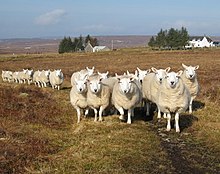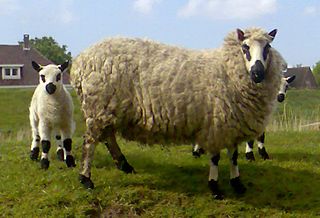

North Country Cheviot is a common breed of sheep raised mainly for meat production. Originated from Scotland.


North Country Cheviot is a common breed of sheep raised mainly for meat production. Originated from Scotland.
In 1791, Sir John Sinclair brought ewes from the Cheviot Hills near the English border to the counties of Caithness and Sutherland in north Scotland. He named these sheep "Cheviots" after the hill area they originated. Another hill breed was introduced into the ranges of central Scotland thus the Scottish Blackface created a definite separation between northern counties of Caithness and Sutherland and the border region in southern Scotland. Most authorities speculate that both English and Border Leicesters may have been introduced into the North Country Cheviots at this time. The result was a larger sheep that had a longer fleece, and one that matured earlier. The North Country is about twice the size of its southern relative.
In 1912, Caithness and Sutherland breeders formed the North Country Sheep Breeders Association to manage shows and sales. In 1945, the organization was reformed into the existing North Country Cheviot Sheep Society for registration, exporting, promotion and breed improvement. [1]
North Country Cheviots are considered a large breed of sheep, they are deep, broad, and long throughout the body. Their head and legs are covered with white, short hair. They have a long roman nose and are polled. the nostrils and eyes are typically outlined with black.
They are a hardy, strong willed, independent breed of sheep that do well in harsh climates and on rough pastures. They are lamb easily with excellent mothering instincts. Their off spring are vigorous at birth and have high survival rates, although they only have an average rate of gain they make up for it in the quality and yield of their carcass. North Country Cheviots are excellent for crossbreeding both through the dam and sire, they pass on their maternal strengths and desirable carcasses to any offspring. The breed has a considerably longer working life than most of the other breeds. [2]
Rams weigh form 100-120kg, ewes weigh form 55-80kg, and their fleece weighs 2–2.3kg [3]

Montadale is the name of a breed of domestic sheep developed in the 1930s by E. H. Mattingly, a Midwestern commercial lamb buyer who had a dream of developing the ideal sheep. He had been told that the best start to that goal would be to bring together the best characteristics of Midwestern mutton-type sheep and the big Western range sheep. The Montadale is considered a dual-purpose breed, raised for both wool and meat.
Polwarth is a breed of sheep that was developed in Victoria (Australia) during 1880. They were of one-quarter Lincoln and three-quarters Merino bloodlines. They are large, predominantly polled sheep with long, soft, quite fine wool and produce good meat carcasses. They were developed in an attempt to extend the grazing territory of sheep because the Merino was found lacking in hardiness in this respect. A dual-purpose breed with a major emphasis on wool production. Richard Dennis, of Tarndwarncoort in south west Victoria, bred the Polwarth, first known as Dennis Comebacks. Descendants of Richards Dennis continue to grow Polwarth wool at Tarndwarncoort, maintaining the original bloodlines in a flock referred to as the "Blue Dots".

The Lincoln, sometimes called the Lincoln Longwool, is a breed of sheep from England. The Lincoln is the largest British sheep, developed specifically to produce the heaviest, longest and most lustrous fleece of any breed in the world. Great numbers were exported to many countries to improve the size and wool quality of their native breeds. The versatile fleece is in great demand for spinning, weaving and many other crafts.

The Cotswold is a British breed of domestic sheep. It originates in, and is named for, the Cotswold hills of the southern midlands of England. It is a large long-woollen sheep, and is kept as a dual-purpose breed, providing both meat and wool.

The Border Leicester is a British breed of sheep. It is a polled, long-wool sheep and is considered a dual-purpose breed as it is reared both for meat and for wool. The sheep are large but docile. They have been exported to other sheep-producing regions, including Australia and the United States.

The Jacob is a British breed of domestic sheep. It combines two characteristics unusual in sheep: it is piebald—dark-coloured with areas of white wool—and it is often polycerate or multi-horned. It most commonly has four horns. The origin of the breed is not known; broken-coloured polycerate sheep were present in England by the middle of the seventeenth century, and were widespread a century later. A breed society was formed in 1969, and a flock book was published from 1972.

The Romney, formerly called the Romney Marsh sheep but generally referred to by the local farmers as the Kent, is a breed of sheep originating in England. The Romney is a "long-wool" breed recognized in England by 1800. Exported to other continents, the Romney is an economically important sheep breed, especially to the sheep-meat and wool export trades of New Zealand.

The Texel is a breed of domestic sheep originally from the island of Texel in the Netherlands. A heavily muscled sheep, it produces a lean meat carcass and will pass on this quality to crossbred progeny. The wool is around 32 micrometres and is mostly used for hosiery yarns and knitting wools. It is presently a popular lean meat sheep across Europe, as well as Australia, New Zealand and the United States.

The Bluefaced Leicester (BFL) is a longwool breed of sheep which evolved from a breeding scheme of Robert Bakewell, in Dishley, Leicestershire in the eighteenth century. First known as the Dishley Leicester, and then the Hexham Leicester, because of the prevalence of the breed in Northumberland, the name Bluefaced Leicester became known at the beginning of the 20th century. In the 1970s, the Bluefaced Leicester was exported to Canada. Exported frozen semen from the United Kingdom is now used to expand the genetic diversity in Canada and the United States. This breed is raised primarily for meat, but their fleece is becoming increasingly popular for handspinning. Bluefaced Leicester sheep may also have brown on their face. The sell record has been set by a brown ram lamb selling for 23,000 guineas.
The Polypay sheep breed is a white, medium-sized, polled sheep which was developed in the 1960s at the U.S. Sheep Experiment Station in Dubois, Idaho. In general, Polypay sheep are noted for being a highly prolific maternal dual-purpose breed. It produces yearly about 4.2 kg of wool and is weaned at 120 days.

The Columbia is one of the first breeds of sheep developed in the United States. The product of USDA and university research, it was intended to be an improved breed adapted for the Western ranges of the country.

The Clun Forest is a breed of domestic sheep originating from the area surrounding the Clun Forest in Shropshire, England. Similar to many of the British breeds of upland sheep, Clun Forest are hardy, adaptable, good foragers, and are long–lived. With sleek heads and wide pelvic structures, Clun Forest ewes lamb easily. The breed has a short to medium–length wool and dark brown faces. They are a multi–purpose animal, kept for meat, wool, and milk. Like other dark faced sheep, Clun produce quality lamb and mutton. However, in contrast to more common meat breeds such as Suffolks, their wool is free of undesirable black fibres and kemp, and is suitable for handspinning. The breed's alert and stylish appearance, together with its reputation for hardiness and fecundity have made it popular with hobby farmers and large commercial flock owners alike. The Official Clun Sheep Breeders Society Show & Sale for males and females is held annually in early September at Ludlow livestock market by McCartneys.

The Charollais is a breed of domestic sheep originating in east central France, in the same region in which Charolais cattle originated, Charolles and Saône-et-Loire. It is known for ease of lambing and is used as a terminal sire to increase muscling and growth rate of the lambs. It has been exported internationally, and is commonly used in the United Kingdom as a sire to produce market lambs from pure-bred ewes and mules.
The Debouillet is a breed of domestic sheep originating from Tatum, New Mexico. It was developed in the 1920s through crossing Rambouillet and Delaine Merino sheep and the breed's name is a portmanteau of these two ancestors. This breed is primarily raised for its wool.

The Kerry Hill is a breed of domestic sheep originating in the county of Powys in Wales. It derives its name from the village of Kerry (Ceri), near Newtown. Kerry Hill sheep have a distinctive and unique coloration, with a white face bearing black markings around the mouth, ears, and eyes. Both rams and ewes are polled. Their wool is white, and their legs are white with black markings. First mentions of the breed date back to the early 19th century, and today it is distributed throughout the United Kingdom, Ireland, the Netherlands, Germany and Denmark. Though still not very numerous, the breed was removed from the records of the Rare Breeds Survival Trust watchlist in 2006. This breed is primarily raised for meat.

The Dalesbred is a breed of domestic sheep originating in England. Derived from the Swaledale and Scottish Blackface breeds, the Dalesbred is a northern hill breed distributed in the Yorkshire Dales and into Lancashire. The Dalesbred is genetically distinct from the other northern hill breeds, the Herdwick and Rough Fell.
The Devon Closewool is a British breed of domestic sheep. It is distributed almost exclusively on Exmoor in North Devon, in south-west England. It is raised primarily for meat.

The Border Cheviot, also known as the South Country Cheviot, is a breed of domesticated sheep from the UK. It is native to the Cheviot Hills between Scotland and England. Recognized as early as 1372, the breed is reported to have developed from sheep that swam ashore from shipwrecked Spanish ships that fled northward after the defeat of the Armada. This breed is prized for its wool but bred primarily for meat.
The Brecknock Hill Cheviot is a domesticated breed of sheep having its origin approximately 400 years ago from Wales. They are a result of crosses with the Welsh Mountain, the Cheviot and the Leicester breeds. This breed is primarily raised for meat. It was introduced into the US in 1838.

The Canadian Arcott is a breed of domestic sheep native to Canada. The latter half of its name is an acronym for the Animal Research Centre in Ottawa, where it was developed along with the Rideau Arcott and the Outaouais Arcott. This breed was a result of a crossbreeding program of Suffolk (37%), Ile de France (28%), Leicester (14%), North Country Cheviot (7%) and Romnelet (6%); the remaining 8% was contributed from Shropshire, Lincoln, Southdown Dorset, East Friesian, Finnsheep and Corriedale.